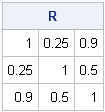Both covariance matrices and correlation matrices are used frequently in multivariate statistics.
You can easily
compute covariance and correlation matrices from data by using SAS software. However, sometimes you are given a covariance matrix, but your numerical technique requires a correlation matrix. Other times you are given a correlation matrix, but you really need the covariance. This article shows how convert from one to the other.
Converting a Correlation Matrix to a Covariance Matrix
In order to convert a
p x p correlation matrix to a covariance matrix, you need the variances (or standard deviations) of the
p variables. Recall that the
ijth element of the correlation matrix is related to the corresponding element of the covariance matrix by the formula
Rij = Sij / mij
where
mij is the product of the standard deviations of the
ith and
jth
variables. You can rescale the correlation matrix by pre- and post-multiplying by a diagonal matrix that contains the standard deviations:
proc iml;
/** convert correlation matrix to covariance matrix **/
R = {1.00 0.25 0.90,
0.25 1.00 0.50,
0.90 0.50 1.00 };
/** standard deviations of each variable **/
c = {1 4 9};
D = diag(c);
S = D*R*D; /** covariance matrix **/
print S; |

Of course, pre-multiplying by a diagonal matrix (that is
D*R) is the same as multiplying each column by the corresponding standard deviation. Similarly, post-multiplying by a diagonal matrix (that is
R*D) is the same as multiplying each row by the corresponding standard deviation. This means that you can also convert the correlation matrix by using the following
(more efficient!) SAS/IML shorthand operations:
A third computation is to implement the formula that relates the correlation and covariance matrices:
Rij = Sij / mij. For example:
Which method is most efficient? I encourage you to
time the performance of each method on large matrices in order to find out.
Converting a Covariance Matrix to a Correlation Matrix
You can use similar operations to convert a covariance matrix to a correlation matrix. First, use the
DIAG function to extract the variances from the diagonal elements of the covariance matrix. Then invert the matrix to form the diagonal matrix with diagonal elements that are the reciprocals of the standard deviations.
/** convert covariance matrix to correlation matrix **/
S = {1.0 1.0 8.1,
1.0 16.0 18.0,
8.1 18.0 81.0 };
/** standard deviations of each variable **/
D = sqrt(diag(S));
DInv = inv(D);
R = DInv * S * Dinv; /** correlation matrix **/
print R; |

Again, you can use SAS/IML shorthand operations to scale the covariance matrix without having to invert a diagonal matrix. This results in code that is much more efficient:
D = sqrt(vecdiag(S));
R2 = S / D` / D; /** divide columns, then divide rows **/ |
The third method, which uses the formula
Rij = Sij / mij, is left as an exercise.
SUBSCRIBE TO THE SAS TECH REPORT
 Of course, pre-multiplying by a diagonal matrix (that is D*R) is the same as multiplying each column by the corresponding standard deviation. Similarly, post-multiplying by a diagonal matrix (that is R*D) is the same as multiplying each row by the corresponding standard deviation. This means that you can also convert the correlation matrix by using the following (more efficient!) SAS/IML shorthand operations:
Of course, pre-multiplying by a diagonal matrix (that is D*R) is the same as multiplying each column by the corresponding standard deviation. Similarly, post-multiplying by a diagonal matrix (that is R*D) is the same as multiplying each row by the corresponding standard deviation. This means that you can also convert the correlation matrix by using the following (more efficient!) SAS/IML shorthand operations:
 Again, you can use SAS/IML shorthand operations to scale the covariance matrix without having to invert a diagonal matrix. This results in code that is much more efficient:
Again, you can use SAS/IML shorthand operations to scale the covariance matrix without having to invert a diagonal matrix. This results in code that is much more efficient:
 Of course, pre-multiplying by a diagonal matrix (that is D*R) is the same as multiplying each column by the corresponding standard deviation. Similarly, post-multiplying by a diagonal matrix (that is R*D) is the same as multiplying each row by the corresponding standard deviation. This means that you can also convert the correlation matrix by using the following (more efficient!) SAS/IML shorthand operations:
Of course, pre-multiplying by a diagonal matrix (that is D*R) is the same as multiplying each column by the corresponding standard deviation. Similarly, post-multiplying by a diagonal matrix (that is R*D) is the same as multiplying each row by the corresponding standard deviation. This means that you can also convert the correlation matrix by using the following (more efficient!) SAS/IML shorthand operations:
 Again, you can use SAS/IML shorthand operations to scale the covariance matrix without having to invert a diagonal matrix. This results in code that is much more efficient:
Again, you can use SAS/IML shorthand operations to scale the covariance matrix without having to invert a diagonal matrix. This results in code that is much more efficient:

5 Comments
Pingback: Convert a covariance matrix to a correlation matrix in SAS - The DO Loop
Pingback: Never multiply with a large diagonal matrix - The DO Loop
Pingback: Sampling from the multivariate normal distribution - The DO Loop
excellent, thank you!
Appreciated! Very well presented!